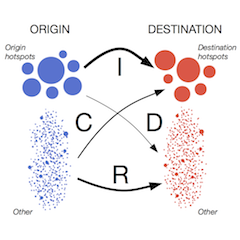
The extraction of a clear and simple footprint of the structure of large, weighted and directed networks is a general problem that has many applications. An important example is given by origin-destination matrices, which contain the complete information on commuting flows, but are difficult to analyze and compare. Marc Barthelemy, and Thomas Louail, together with their collaborators proposed a versatile method [1], which extracts a coarse-grained signature of mobility networks, under the form of a 2x2 matrix that separates the flows into four categories. They applied this method to origin-destination matrices extracted from mobile phone data recorded in 31 Spanish cities and showed that these cities essentially differ by their proportion of two types of flows: integrated (between residential and employment hotspots) and random flows, whose importance increases with city size. More generally, this method allows to determine categories of networks, and in the mobility case to classify to their commuting structure.
[1] Uncovering the spatial structure of mobility networks, Nature Communications (published online 21 january 2015). T. Louail, M. Lenormand, M. Picornell, O. Cantu, R. Herranz, E. Frias-Martinez, J. Ramasco & M. Barthelemy

